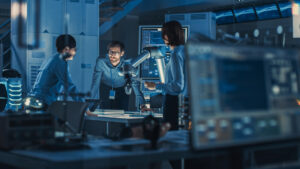Introduction to transportation and AI

Get ready to buckle up and take a ride into the future of transportation! As AI continues to advance, we’re on the brink of a new era where self-driving cars and flying vehicles will soon become a common sight on our roads and skies. But before we explore the exciting possibilities of this technology, let’s first take a look at the key technologies that are driving this revolution in transportation.
Are you ready for a world where your car not only drives itself, but can also detect objects in its environment and recognize sounds? Thanks to a host of key technologies, this futuristic world is closer than you think!
Key technologies in transportation
GPS, smartphones, and a wide range of sensors have all played a crucial role in enabling the widespread adoption of AI in transportation. GPS, for example, has become a fundamental part of our transportation infrastructure, assisting drivers and providing valuable data to cities and tech companies about transportation patterns. Smartphones, on the other hand, have increased connectivity and the amount of location data shared by individuals.
But it’s not just GPS and smartphones that are driving this revolution. Sensors, too, have become an indispensable part of the modern car. An average vehicle in the US is expected to have around 70 sensors, including gyroscopes, accelerometers, ambient light sensors, and moisture sensors. These sensors, combined with deep learning algorithms, are helping cars to detect objects in their environment and make smarter, safer decisions on the road.
So buckle up, folks, because the future of transportation is looking smarter and more connected than ever before!
Smarter cars
Gone are the days when your car was just a boring, old hunk of metal that got you from point A to point B. These days, even the most basic cars are packed with all kinds of smart features that make driving safer, more comfortable, and even a little bit fun.
Sure, you might not have a self-driving car just yet, but that doesn’t mean your vehicle can’t assist you on the road. Modern cars are equipped with a whole range of sensors that can help you avoid collisions, stay in your lane, and even park in tight spots. And thanks to vision and radar technology, your car can even autonomously brake if it detects a potential collision.
But that’s not all. Thanks to deep learning algorithms, your car can also detect objects in its environment and recognize sounds. So whether you’re trying to parallel park or avoid a pesky squirrel on the road, your car has got your back.
In short, the future of transportation is looking brighter (and smarter) than ever!
Self-driving vehicles
Hold onto your steering wheels, folks, because the future of transportation is looking self-driving! That’s right, the technology that once seemed like the stuff of science fiction is now a very real possibility, and it’s set to revolutionize the way we get around.
But how does it work, exactly? Well, thanks to a combination of sensors, deep learning algorithms, and high-powered computing, self-driving cars are able to perceive their environment, make decisions, and navigate roads without any human input. And while the technology is still in its early stages, it’s already showing tremendous potential.
Self-driving cars can navigate roads more safely and efficiently than human drivers, and they could even help to reduce traffic congestion and cut down on emissions. And with companies like Google and Tesla leading the charge, it won’t be long before self-driving cars become a common sight on our roads.
So if you’re excited about the future of transportation, keep your eyes on the road (or lack thereof) because the self-driving revolution is coming!
City-level impacts of self-driving cars
Get ready to say goodbye to traffic jams and hello to a whole new way of living, because the future of transportation is looking downright futuristic! Thanks to self-driving cars, city-dwellers will soon be able to live further from work, own fewer cars, and spend their time in entirely new ways.
But what does this mean for our cities? Well, for starters, self-driving cars will require a whole new infrastructure to support them. From specialized lanes and traffic signals to communication systems that allow cars to “talk” to each other, our cities will need to adapt in order to accommodate this new technology.
But that’s not all. Self-driving cars will also change the way we interact with our cities. With cars doing the driving for us, we’ll be able to relax, work, or even sleep during our commutes. And that means we’ll be able to live further from our jobs, which could lead to entirely new patterns of urban development.
In short, the future of transportation is looking bright, and it’s going to change the way we live in our cities. So buckle up and get ready for the ride of a lifetime!
Flying vehicles and personal robots in the future
Attention, all futurists and tech enthusiasts: get ready for a world where cars can fly and personal robots roam the streets! That’s right, the future of transportation is looking downright sci-fi, with flying vehicles and personal robots set to become a common sight in our cities.
But how will these technologies work, exactly? Well, flying vehicles will likely use a combination of advanced propulsion systems and sophisticated AI algorithms to navigate the skies safely and efficiently. And personal robots, on the other hand, will use sensors, cameras, and deep learning algorithms to interact with their environment and assist people with a wide range of tasks.
But these technologies will raise a host of social, ethical, and policy issues. How will flying vehicles and personal robots be regulated? And what impact will they have on our cities and our way of life? These are just a few of the questions that we’ll need to answer as we embrace this exciting new era of transportation.
So strap in, folks, because the future of transportation is looking wilder than ever!
